

President: Brigadier R.J.Baddeley
There are 50 hillside figures of many descriptions, in the U.K., 20 are in Wiltshire, and the largest group of 12 can be viewed from laybys on the A 30 road passing through Fovant, a village midway between Salisbury and Shaftesbury, Dorset. At the beginning of the Great War 1914 1918 land was commandeered to provide for the training of the New Army'
At Fovant this was the largest of many such camps: billets and training areas, together with powerhouses, water pumping stations from deep bore wells, firing ranges, practice for bayonets and grenade throwing, parade grounds, mule lines, YMCA, a Garrison Cinema, a large hospital, all served by a railway link from the main line at Dinton, with a station and marshalling yard at Fovant. The camp stretched both sides of the A 30 road, from Sutton Mandeville (beneath the Swallowcliffe Downs) through Fovant Down, Compton Chamberlayne, and to the outskirts of Barford St Martin.
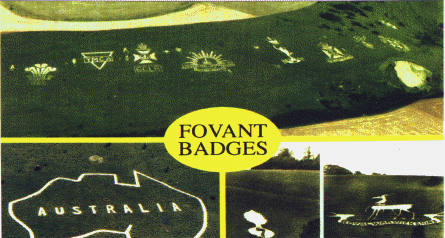
Not all were able to devote the amount of time necessary to dig deep into the turf, make a trench outline and then back fill with chalk, these were identifiable at a later date, whilst others, made by placing chalk on top of the turf, augmented by broken crockery, bricks and tiles, quickly disappeared without trace.
Badges to be seen today include a Map of Australia (Compton Chamberlayne), and at Fovant, The Royal Wiltshire Yeomanry; 6th City of London Regiment (The Cast Iron Sixth); The Australian Commonwealth Military forces; The Royal Corps of Signals; The Wiltshire Regiment; The London Rifle Brigade; 8th City of London Regiment (The Post Office Rifles ); The Devonshire Regiment; and at Sutton Mandeville, The 7th City of London Regiment (The Shiny Seven); The Royal Warwickshire Regiment.
Nine are original to the 1916 period, and were restored by the Fovant Home Guard Old Comrades, following the 1939 - 1945 War, when they added their own cap badge, the Wiltshire Regiment, and that of the Royal Wiltshire Yeomanry.
Following the last war 1939 - 45, the Fovant Home Guard Old Comrades Association, were approached by some of the London Regiments, and asked to investigate the condition of the badges, with the possibility of restoration. In 1949 a survey took place, and it was decided that a start could be made, on the badges that could be more clearly identified, for they had been more deeply dug into the turf of the downs.
Within a five year period, nine of the original badges had been restored, and during this period, the Home Guard Platoon, introduced their own badge, that of the Wiltshire Regiment, to be followed by the Royal Wiltshire Yeomanry.
The badge of the Royal Corps of Signals, was added in 1970, to commemorate their 50th anniversary.
Sadly many of the regiments whose badges grace the downs, are now disbanded, or are amalgamated, and it is difficult to identify allegiance, many have vital commitments, making it difficult for them to guarantee working parties, with any regularity.
This leaves the society with the problem of engaging paid labour, but with limited finances for this annual operation; each year the monies available runs out long before the essential tasks are completed. This gradual deterioration of the badges, leads to further intent work to put things right.
The sizes of the badges are almost impossible to imagine for those who view them from the roadway, the largest, that of the Australian Commonwealth Military Forces, from one end of the lettering scroll to the other, is equal to the length of three cricket pitches (66 yards). The amount of corrective grass cutting and weed removal can be imagined.
Following the restoration work of the early 1950s, in 1954 a reunion was arranged for members of the Fovant Home Guard Old Comrades, with members of the Old Comrades Associations of the London Regiments, to attend a Drumhead Service at Fovant, and to view the work on the badges.
This was very well supported, and since then an Annual Drumhead service has been held on the First Sunday (Sunday 14th July 2002) In July ever since, this is attended by many ex-servicemen and their families, many with associations with Fovant Camp. the service is held on the lawn of the Firs, East Farm, Fovant, commencing at 3.00pm, all welcome. This date had been changed to Sunday 14th July 2002.
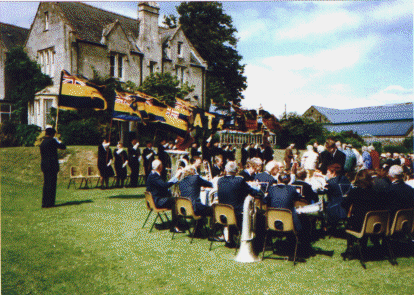
Drumhead Service on the lawn at The Firs, East Farm, Fovant
The main theme of the service is the remembrance of all servicemen especially those of the 1914-1918 War, who were trained at Fovant Camp, and left behind their regimental crests on the Downs, before embarking to the Western Front.
The Fovant Badges Society was established in 1963, with the objects stated as the "Preservation and Maintenance of the Regimental Crests, on the Downs at Compton Chamberlayne, Fovant and Sutton Mandeville, in the County of Wiltshire"
Registered Charity No. 1045087
The Fovant Home Guard Old Comrades Association first met on 21st December 1944, when 21 members assembled at the Pembroke Arms, Fovant, which had been the Platoon headquarters throughout the war. They agreed to adopt 'Rules for the Association", and additional names were offered membership. A Management Committee was formed consisting of Chairman; Secretary; Treasurer and three members elected by ballot. Regular social evenings were arranged, and an Annual Flower show; eventually the membership was opened up to include any resident of Fovant, Compton Chamberlayne and Sutton Mandeville.
During 1949, the Association accepted contracts, with the governing bodies of the 6th City of London Rifles; the London Rifle Brigade and the Post Office Rifles, to trace and if possible restore their respective badges on the downs.
The annual subscription from members of 3/- per annum, allowed volunteers to be paid for work carried out in their spare time, and the sum of £19.5s.0d was spent in the first season. Negotiations began for the restoration of the Australian "Rising Sun" badge, and in the mean time it was decided to cut the badge of the Wiltshire Regiment, the cap-badge of the Platoon, but volunteers would not be paid for this.
The 7th City of London Regiment requested that their badge be restored, and by the end of 1950 others followed suit. It was decided that the Association would strive to obtain local subscriptions to enable the Map of Australia, and the Australia "Rising Sun" badge to be restored at no cost to the Australian Commonwealth, as a gesture of appreciation for their help to the country during and since the war.
A request also came for the cutting of the badge of the Royal Wiltshire Yeomanry, by tradition on the right of the line. By 1952 eleven badges were restored, thanks to members' subscriptions, and donations from regiments, but the Association was very short of money, and it was decided to apply to the bank for a loan, to enable a booklet about the badges and the regiments to be printed for general sale, to raise funds for further work. In 1954 regiments were invited to see the badges, with a reunion at Fovant, and the first Drumhead Service was held on Sunday 26th June 1955, and continues today (now 1st Sunday in July), in the garden of the Firs, East Farm Fovant, commencing at 3.00pm.
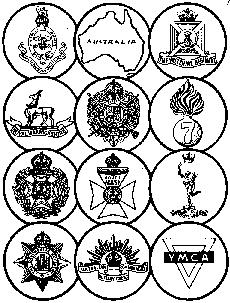
The outlines that did not survive were made quickly and merely resulted in lumps of chalk laid on the surface of the turf, to be augmented by Bricks, tiles and broken crockery, these were easily dispersed, and completely disappeared.
Emblems acknowledged as being on the downs at that period are: - An outline of a Kangaroo; The Royal Army Service Corps; The Royal Army Medical Corps; The Machine Gun Corps; The Queen Victoria Rifles; A Drum surrounded by lettering; The V.A.D and the Red Cross.
Annual attendance is required to remove vast weed growth, overgrowing grasses, animal damage, and the tendency for chalk on a 40 degree slope to travel downwards.
Over the years many working parties have concentrated on a quick improvement of the outline, by placing more and more chalk on top of the existing, this has shown an immediate result when viewed from the road, but after a few months the chalk spreads and the end result is so problematical that some parties, instead of removing the excess chalk, have tried to hold it back with shuttering, using such materials as timber posts, planks, sandbags, and corrugated iron sheeting, thereby creating another more serious problem for its eventual removal.
The society is now engaged in a systematic programme for the removal of all the added shuttering and the excess chalk, reducing the badges to their original outline, and at the same time, recovering from the way in which dead grasses have 'spread' the true shape of the badge; eventually to be able to rechalk.
This programme which will take many years to achieve success, will only be possible with the necessary financing, and it is with regret that we are unable to establish any support from the National Heritage Lottery Fund, or any Government Departments, not without trying!
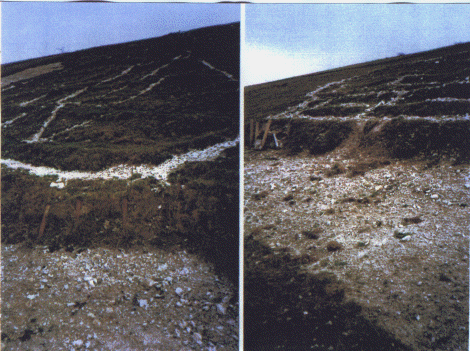
From these photographs can be seen the enormous task of removing chalk and debris.
And the difficult working conditions.
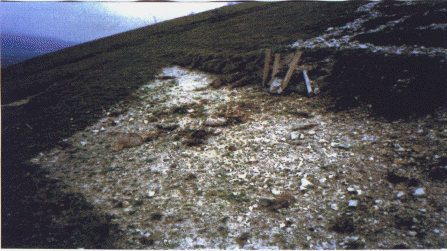
Our efforts each season are therefore restricted not by enthusiasm, but by finance, and we are ever striving to apply the maximum results according to the monies available.
Although the outlines are recognisable from the roadway, viewing at a distance of about three quarters of a mile; at close quarters the enormity of the problem can be assessed, the remains of shuttering, the spread of chalk, and the damage by nature and animals.
To be able to attack and rectify all these problems in one season would be an advantage and desirable, but not possible without the financial backing.
In order to ensure the future of the badges on the downs, in the 21st Century, then we must ask for continued and increased support.
The membership of the society is depleting, and we urgently seek for new members, the annual subscription is not a fixed sum, but that which a member feels that they can afford, and can be paid by cheque, bankers order, or covenant (forms available on request); the other source of income is the sale of publications, donations from regiments and local fund raising.
1. Fovant Badges Booklet "Badges in the Chalk" (Grey Booklet) 2. History of Fovant Badges Society (Booklet) 3. Map of Fovant Training Camp 1914- 1918 4. Regiments and Dates in training at Fovant Camp 5. List of War Graves in the Area 6. Booklet - Fovant Camp and the Building of the Badges 7. Booklet - Regimental histories of the Badges on the Downs 8. Booklet Fovant Home Guard Old Comrades Association Extracts from the "Home Guard Nadder Journal" 9. Coloured Postcards 10. Philatelic First day Covers - 1980
Available on request from the Publications Officer Fovant Badges Society 1 Rookery Close Gillingham Dorset SP8 4LH

PATRON: Major General Lord Michael Fitzalan Howard GCVO CB CBE MC DL PRESIDENT: General Sir John Wilsey GCB CBE DL CHAIRMAN: Brigadier R J Baddeley DL HON SECRETARY TREASURER Miss Sarah Vigors Apshill House Lower Chicksgrove Tisbury Salisbury, Wiltshire SP3 6NB Sir Donald Stringer CBE Beech Cottage Barford St Martin Salisbury, Wiltshire SP3 4AS TEL: 01722 714662 overseas code: +44 (0)1722 714662 TEL: 01722 744318 overseas code: +44 (0)1722 744318 EMAIL: sarahvig@waitrose.com Drumhead Service Co-ordinator Lt Col Alan Dickins Membership Officer. David Greenwood - email - davidgreenwood@waitrose.com PUBLICATIONS OFFICER AND WEBSITE MANAGER Mr Frank Hallett 1 Rookery Close Gillingham, Dorset SP8 4LH TEL: 01747 824139 overseas code: +44 (0)1747 824139 For further information about the Fovant Badges - Please contact The Secretary Fovant Badges Society Fovant Salisbury Wiltshire SP3 5LJ
Produced on behalf of the Fovant Badges Society